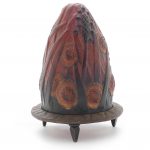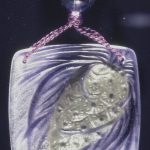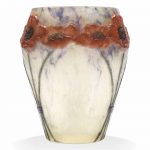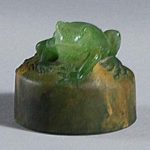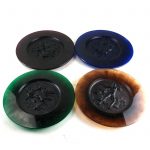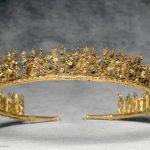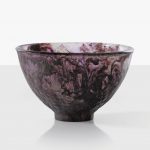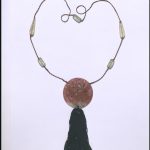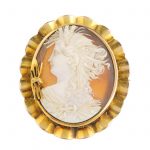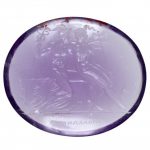Pâte de verre is a form of kiln casting and literally translated means glass paste. In this process, finely crushed glass is mixed with a binding material, such as a mixture of gum arabic and water, and often with colourants and enamels. The resultant paste is applied to the inner surface of a negative mould forming a coating. After the coated mould is fired at the appropriate temperature the glass is fused creating a hollow object that can have thick or thin walls depending on the thickness of the pate de verre layers. Daum, a French commercial crystal manufacturer, produce highly sculptural pieces in pate de verre. Reference: Wikipedia
Gabriel Argy-Rousseau (French, 1885-1953) ‘The Prairie’ a Pâte de Verre Nightlight, circa 1926 decorated with broken diagonal lines on different planes contrasting with circles of flowers 16cm high, moulded ‘G.Argy-Rousseau France’
Sold for £2,625 inc. premium at Bonhams in 2015
Pendant; moulded glass or pâte-de-verre, square shape, a green pine-cone with purple needles, on a clear ground, suspended from a purple silk cord with purple glass bead; contained in its original retailer’s cardboard case labelled ‘Liberty, London and Paris’.
Designed by: Joseph-Gabriel Argy-Rousseau biographyOriginally retailed by: Liberty & Co biographyWorkshop of: Société des Pâtes de verre biography Date1921
Reference: © The Trustees of the British Museum
‘COQUELICOTS’. A GABRIEL ARGY-ROUSSEAU (1885-1963) PATE-DE-VERRE VASE DESIGNED 1924, SIGNED IN THE MOULD G. ARGY-ROUSSEAU, FRANCE 7 in. (18 cm.) high
Sold for GBP 8,125 at Christies in 2018
Almeric Walter and Henri Berge Pate de Verre and Pate de Crystal Animalier Weight In green glass, modeled as a seated frog, ending in a circular base. Height 1 3/4 inches, diameter 1 7/8 inches.
Appears to be in restored condition: a large area on the back side of the base appears to be infilled to conceal and replace a loss to the glass.
Sold for $570 (includes buyer’s premium) at Doyle New York in 2006
Set of four pate de verre multi-color relief chargers depicting the four seasons, by Daum Nancy – France. [Each: 10 1/2 (dia) inches].
Sold for $200 at Roland NY in 2018
The necropolis in Canosa has provided splendid examples of the refinement of women’s jewelry in the Hellenistic period. This diadem features exuberant, richly inventive decoration typical of the floral style developed by Greek goldsmiths in southern Italy, especially Taranto, in the 3rd century BC. Palmettes, rosettes, and intertwining foliage form a tracery in gold and enamel, worthy of the finest lace. The piece is dotted with tiny colored glass beads.
The diadem’s decoration is extraordinarily inventive and technically accomplished, comprising an openwork tracery of luxuriant stems dotted with palmettes, rosettes, foliage, and a variety of flowers. The motifs are intertwined like fine lace, highlighted with gold filigree work, blue enamel, and berries made from green, white, and blue pâte de verre. The piece is clearly the work of a Greek goldsmith influenced by Oriental styles and jewelry created for the royal court of Macedonia in the 4th century BC. The diadem is typical of the naturalistic decorative style seen in northern Greek jewelry and precious metalwork from 375-350 BC.
The diadem was made during the Hellenistic period, in the 3rd century BC, by a goldsmith active at Canosa in southern Italy, or possibly a workshop in Taranto. Greek metalworking flourished in Apulia during this period; women’s jewelry based on northern Greek designs using abundant flowers and foliage was especially popular. Items made in Taranto were exported throughout the surrounding region, as well as to Campania and Etruria. The innovative workshops of Taranto pioneered the reduction of the base plate to a plain background, focusing our attention solely on the scrolling, openwork design.
Reference:The Louvre
François-Émile Décorchemont BOWL, CIRCA 1925 pâte-de-verre With artist’s stamp DECORCHEMONT and engraved number A367 on the underside 10,7 x 18,2 cm ; 4 1/4 x 7 1/8 in.
Sold for 2,500 EUR at Sothebys in 2017
Necklace, Hydrangeas, moulded glass, silk, Paris, designed by Gabriel Argy-Rousseau, 1921.
The pendant shows Japanese influence. Argy-Rousseau exhibited his first pâte-de-verre in 1914 and founded the company which bore his name in 1921. In the period until its liquidation in 1931, is estimated to have made up to fifty examples of each design. In London, comparable pendants by him were sold by Liberty’s for about �6-10s between 1929 and 1932.
Reference: © Victoria and Albert Museum
